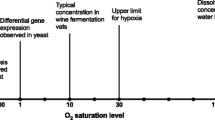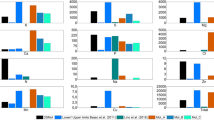Abstract
This work investigated the effects of increasing temperature from 30°C to 47°C on the physiological and genetic characteristics of Saccharomyces cerevisiae strain 63M after continuous fermentation with cell recycling in a system of five reactors in series. Steady state was attained at 30°C, and then the temperature of the system was raised so it ranged from 35°C in the last reactor to 43°C in the first reactor or feeding reactor with a 2°C difference between reactors. After 15 days at steady state, the temperature was raised from 37°C to 45°C for 25 days at steady state, then from 39°C to 47°C for 20 days at steady state. Starter strain 63M was a hybrid strain constructed to have a MAT a/α, LYS/lys, URA/ura genotype. This hybrid yeast showed vigorous growth on plates at 40°C, weak growth at 41°C, positive assimilation of melibiose, positive fermentation of galactose, raffinose and sucrose. Of 156 isolates obtained from this system at the end of the fermentation process, only 17.3% showed the same characteristics as starter strain 63M. Alterations in mating type reaction and in utilization of raffinose, melibiose, and sucrose were identified. Only 1.9% of the isolates lost the ability to grow at 40°C. Isolates showing requirements for lysine and uracil were also obtained. In addition, cell survival was observed at 39–47°C, but no isolates showing growth above 41°C were obtained.



Similar content being viewed by others
References
Adams A, Gottschling DE, Kaiser CA, Stearns T (1997) Methods in yeast genetics: a Cold Spring Harbor laboratory course manual. Cold Spring Harbor Laboratory Press, Cold Spring Harbor, New York
Barnett JA, Payne RW, Yarrow D (2000) Yeasts: characteristics and identification, 3rd edn. Cambridge University Press, Cambridge
Bertolini MC, Ernandes JR, Laluce C (1991) New yeast strains for alcoholic fermentation at higher sugar concentration. Biotechnol Lett 13:197–202, DOI 10.1007/BF01025817
Booth C (1971) Fungal culture media. In: Booth C (ed) Methods in microbiology. Academic Press Inc, London, pp 49–94
Briones AI, Ubeda J, Grando MS (1996) Differentiation of Saccharomyces cerevisiae strains isolated from fermenting musts according to their karyotype patterns. Int J Food Microbiol 28:369–377
Chan RK (1977) Recovery of Saccharomyces cerevisiae mating-type a cells from G1 arrest by α factor. J Bacteriol 130:766–774
Codón AC, Benitez T (1995) Variability of the physiological features and of the nuclear and mitochondrial genomes of Baker’s Yeasts. Syst Appl Microbiol 18:343–352
Codón AC, Benítez T, Korhola M (1997) Chromosomal reorganization during meiosis of Saccharomyces cerevisiae baker’s yeasts. Curr Genet 32:247–259, DOI 10.1007/s002940050274
Codón AC, Gasent-Ramírez JM, Benítez T (1995) Factors which affect the frequency of sporulation and tetrad formation in Saccharomyces cerevisiae baker’s yeasts. Appl Environ Microbiol 61:630–638
Costa V, Amorim MA, Reis E, Quintanilha A, Moradas-Ferreira P (1997) Mitochondrial superoxide dismutase is essential for ethanol tolerance of Saccharomyces cerevisie in the post-diauxic phase. Microbiology 143:1649–1656
D’Amato D, Corbo MR, Del Nobile MA, Sinigaglia M (2006) Effects of temperature, ammonium and glucose concentrations on yeast growth in a model wine system. Int J Food Sci Technol 41:1152–1157, DOI 10.1111/j.1365-2621.2005.01128.x
Davidow LS, Goetsch L, Byers B (1980) Preferential occurrence of nonsister spores in two-spored asci of Saccharomyces cerevisiae: evidence for regulation of spore-wall formation by the spindle pole body. Genetics 94:581–595
Davidson JF, Schiestl RH (2001) Cytotoxic and genotoxic consequences of heat stress are dependent on the presence of oxygen in Saccharomyces cerevisiae. J Bacteriol 183:4580–4587, DOI 10.1128/JB.183.15.4580-4587.2001
Ernandes JR, Matulionis M, Cruz SH, Bertolini MC, Laluce C (1990) Isolation of new ethanol-tolerant yeasts for fuel ethanol-production from sucrose. Biotechnol Lett 12:463–468, DOI 10.1007/BF01024406
Gardiner WP (1997) Statistical analysis methods for chemists: a software-based approach. The Royal Society of Chemistry, Cambridge, UK, pp 6–8
Gasch AP, Werner-Washburne M (2002) The genomics of yeast responses to environmental stress and starvation. Funct Integr Genomics 2:181–192
Gasent-Ramírez JM, Codón AC, Benítez T (1995) Characterization of genetically transformed Saccharomyces cerevisiae Baker’s yeasts able to metabolize melibiose. Appl Environ Microbiol 61:2113–2121
Gerring SL, Connelly C, Hieter P (1991) Positional mapping of genes by chromosome blotting and chromosome fragmentation. Methods Enzymol 194:55–77
Heidenreich E, Wintersberger U (1997) Starvation for a specific amino acid induces high frequencies of rho- mutants in Saccharomyces cerevisiae. Curr Genet 31:408–413, DOI 10.1007/s002940050223
Heidenreich E, Wintersberger U (1998) Replication-dependent and selection-induced mutations in respiration-competent and respiration-deficient strains of Saccharomyces cerevisiae. Mol Gen Genet 260:395–400
Jakubowski H, Goldman E (1988) Evidence for cooperation between cells during sporulation of the yeast Saccharomyces cerevisiae. Mol Cell Biol 8:5166–5178
Jaquet L, Jauniaux JC (1999) Disruption and basic functional analysis of five chromosome X novel ORFs of Saccharomyces cerevisiae reveals YJL125c as an essential gene for vegetative growth. Yeast 15:51–61
Keiding AK (1985) Genetic and molecular characterization of a distiller’s yeast. Carlsberg Res Commun 50:95–125
Kolodner RD, Putnam CD, Myung K (2002) Maintenance of genetic stability in Saccharomyces cerevisiae. Science 297:552–557
Laluce C, Souza CS, Abud CL, Gattas EAL, Walker GM (2002) Continuous ethanol production in a nonconventional five-stage system operating with yeast cell recycling at elevated temperatures. J Ind Microbiol Biotechnol 29:140–144, DOI 10.1038/sj.jim.7000294
Lobrich M, Ikpeme S, Haub P, Weber KJ, Kiefer J (1993) DNA double-strand break induction in yeast by X-rays and α-particles measured by pulsed-field gel electrophoresis. Int J Radioat Biol 64:539–546
Malone RE, Bullard S, Lundquist S, Kim S, Tarkowski T (1992) A meiotic gene conversion gradient opposite to the direction of transcription. Nature 359:154–155
Marinoni G, Manuel M, Petersen RF, Hvidtfeldt J, Sulo P, Piskur J (1999) Horizontal transfer of genetic material among Saccharomyces yeasts. J Bacteriol 181:6488–6496
Middelhoven WJ (2001) Identification of yeasts present in sour fermented foods and fodders. In: Spencer JF, Spencer ALR (eds) Methods in biotechnology: food microbiology protocols, vol 14. Humana Press Inc, New Jersey, pp 209–224
Mortimer RK (2000) Evolution and variation of the yeast (Saccharomyces) genome. Genome Res 10:403–409
Mortimer RK, Romano P, Suzzi G, Polsinelli M (1994) Genome renewal: a new phenomenon revealed from a genetic-study of 43 strains of Saccharomyces cerevisiae derived from natural fermentation of grape musts. Yeast 10:1543–1552
Nadal D, Carro D, Fernández-Larrea J, Pina B (1999) Analysis and dynamics of the chromosomal complements of wild sparkling-wine yeast strains. Appl Environ Microbiol 65:1688–1695
Nakai A, Ishikawa T (2001) Cell cycle transition under stress conditions controlled by vertebrate heat shock factors. EMBO J 20:2885–2895, DOI 10.1093/emboj/20.11.2885
Naumov GI, Naumova ES, Korshunova IV, Jakobsen M (2002) Yeast comparative genetics: a new MEL15 α-galactosidase gene of Saccharomyces cerevisiae. Russ J Genet 38:1127–1132
Naumov GI, Naumova ES, Turakainen H, Korhola M (1996) Identification of the α-galactosidase MEL genes in some populations of Saccharomyces cerevisiae: a new gene MEL11. Genet Res 67:101–108
Nissen P, Nielsen D, Arneborg N (2003) Viable Saccharomyces cerevisiae cells at high concentrations cause early growth arrest of non-Saccharomyces yeasts in mixed cultures by a cell-cell contact-mediated mechanism. Yeast 20:331–341, DOI 10.1002/yea.965
Okamoto S, Iino T (1981) Selective abortion of two nonsister nuclei in a developing ascus of the hfd-1 mutant in Saccharomyces cerevisiae. Genetics 99:197–209
Pasero P, Marilley M (1993) Size variation of rDNA clusters in the yeasts Saccharomyces cerevisiae and Schizosaccharomyces pombe. Mol Gen Genet 236:448–452
Piper PW (1995) The heat shock and ethanol stress responses of yeast exhibit extensive similarity and functional overlap. FEMS Microbiol Lett 34:121–127, DOI 10.1016/0378–1097(95)00431–9
Polsinelli M, Romano P, Suzzi G, Mortimer R (1996) Multiple strains of Saccharomyces cerevisiae on a single grape vine. Lett Appl Microbiol 23:110–114
Puig S, Querol A, Barrio E, Pérez-Ortín JE (2000) Mitotic recombination and genetic changes in Saccharomyces cerevisiae during wine fermentation. Appl Environ Microbiol 66:2057–2061
Querol A, Fernández-Espinar MT, Del Olmo M, Barrio E (2003) Adaptive evolution of wine yeast. Int J Food Microbiol 86:3–10, DOI 10.1016/S0168-1605(03)00244-7
Rachidi N, Barre P, Blondin B (1999) Multiple Ty-mediated chromosomal translocations lead to karyotype changes in a wine strain of Saccharomyces cerevisiae. Mol Gen Genet 261:841–850
Rakauskaite R, Chitavichius D (2003) The genetic control of cell growth and development in yeast Saccharomyces cerevisiae. Disturbed sporulation in diploids with decreased activity of the Ras/cAMP signal transduction pathway. Genetika 39:739–747
Ramírez M, Vinagre A, Ambrona J, Molina F, Maqueda M, Rebollo JE (2004) Genetic instability of heterozygous, hybrid, natural wine yeasts. Appl Environ Microbiol 70:4686–4691, DOI 10.1128/AEM.70.8.4686-4691.2004
Scandalios JG (2005) Oxidative stress: molecular perception and transduction of signals triggering antioxidant gene defenses. Braz J Med Biol Res 38:995–1014
Schwartz DC, Cantor CR (1984) Separation of yeast chromosome-sized DNAs by pulse-field gradient gel electrophoresis. Cell 37:67–75
Sherman F, Hicks J (1991) Micromanipulation and dissection of asci. Methods Enzymol 194:21–37
Stolzenburg W (1990) Hypermutation: evolutionary fast track. Sci News 137:391
Tamaki H (1986) Genetic analysis of intergeneric hybrids obtained by protoplast fusion in yeasts. Curr Genet 10:491–494
Tani Y, Tomohiro Y, Miyata A, Furukawa K, Hayashida S (1993) E ndomitotic diploidization of Saccharomyces cerevisiae by heat treatment during spore germination. Yeast 9:519–521
Turakainen H, Aho S, Korhola M (1993) MEL gene polymorphism in the genus Saccharomyces. Appl Environ Microbiol 59:2622–2630
Velkov VV (1999) How environmental factors regulate mutagenesis and gene transfer in microorganisms. J Biosci 24:529–559
Acknowledgements
The authors gratefully acknowledge Dr Sandra R. P. Sponchiado for the careful reading of this manuscript and Fernando Delfino for his technical assistance.
Author information
Authors and Affiliations
Corresponding author
Rights and permissions
About this article
Cite this article
Souza, C.S., Thomaz, D., Cides, E.R. et al. Genetic and physiological alterations occurring in a yeast population continuously propagated at increasing temperatures with cell recycling. World J Microbiol Biotechnol 23, 1667–1677 (2007). https://doi.org/10.1007/s11274-007-9414-7
Received:
Accepted:
Published:
Issue Date:
DOI: https://doi.org/10.1007/s11274-007-9414-7




